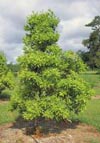Home >
Persea borbonia, Redbay
Thriving on little care in full sun or partial shade, Redbay can tolerate a wide range of soils, from hot and dry to wet and swampy. Redbay is a rugged and adaptable plant suitable to many landscape applications including coastal beach front property. Indeed trees grow on sand dunes in their natural habitat. I have seen it along coastal waterways with roots dangling in the brackish water. Trees are very tolerant of urban conditions and have survived and grow well along streets.
Trees occur naturally in every county in Florida.
Unfortunately, the wood is reportedly brittle and subject to wind damage. Pruning to keep lateral branches less than half the diameter of the trunk will increase the tree's longevity and help prevent branches from separating from the trunk. Trees are considered poor compartmentalizers of decay. This means decay can develop and spread quickly following mechanical injury from construction activities near the tree, vandalism, storm damage, or improper pruning cuts. Plant with caution where cars will park or near sidewalks since birds love the fruit and often visit the tree, leaving their droppings on cars. The fruit can also be messy on cars and walks. Foliage is distinctively aromatic when crushed. Susceptible to a foliage deforming gall that does not affect the tree's health.
Wood is considered diffuse porous meaning that there is little difference in size of pores between spring and summer wood.
Plants
serve as hosts for palamedes swallowtail (Papilio palamedes) and
spicebush swallowtail (Palilio troilus) butterfly larvae.






